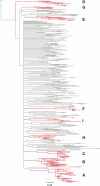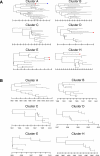Episodic sexual transmission of HIV revealed by molecular phylodynamics
- PMID: 18351795
- PMCID: PMC2267814
- DOI: 10.1371/journal.pmed.0050050
Episodic sexual transmission of HIV revealed by molecular phylodynamics
Abstract
Background: The structure of sexual contact networks plays a key role in the epidemiology of sexually transmitted infections, and their reconstruction from interview data has provided valuable insights into the spread of infection. For HIV, the long period of infectivity has made the interpretation of contact networks more difficult, and major discrepancies have been observed between the contact network and the transmission network revealed by viral phylogenetics. The high rate of HIV evolution in principle allows for detailed reconstruction of links between virus from different individuals, but often sampling has been too sparse to describe the structure of the transmission network. The aim of this study was to analyze a high-density sample of an HIV-infected population using recently developed techniques in phylogenetics to infer the short-term dynamics of the epidemic among men who have sex with men (MSM).
Methods and findings: Sequences of the protease and reverse transcriptase coding regions from 2,126 patients, predominantly MSM, from London were compared: 402 of these showed a close match to at least one other subtype B sequence. Nine large clusters were identified on the basis of genetic distance; all were confirmed by Bayesian Monte Carlo Markov chain (MCMC) phylogenetic analysis. Overall, 25% of individuals with a close match with one sequence are linked to 10 or more others. Dated phylogenies of the clusters using a relaxed clock indicated that 65% of the transmissions within clusters took place between 1995 and 2000, and 25% occurred within 6 mo after infection. The likelihood that not all members of the clusters have been identified renders the latter observation conservative.
Conclusions: Reconstruction of the HIV transmission network using a dated phylogeny approach has revealed the HIV epidemic among MSM in London to have been episodic, with evidence of multiple clusters of transmissions dating to the late 1990s, a period when HIV prevalence is known to have doubled in this population. The quantitative description of the transmission dynamics among MSM will be important for parameterization of epidemiological models and in designing intervention strategies.
Conflict of interest statement
Figures






Comment in
-
Inferring HIV transmission dynamics from phylogenetic sequence relationships.PLoS Med. 2008 Mar 18;5(3):e69. doi: 10.1371/journal.pmed.0050069. PLoS Med. 2008. PMID: 18351799 Free PMC article.
-
It's the network, stupid: why everything in medicine is connected.PLoS Med. 2008 Mar 25;5(3):e71. doi: 10.1371/journal.pmed.0050071. PLoS Med. 2008. PMID: 18366249 Free PMC article.
References
-
- Doherty IA, Padian NS, Marlow C, Aral SO. Determinants and consequences of sexual networks as they affect the spread of sexually transmitted infections. J Infect Dis. 2005;191:S42–S54. - PubMed
-
- Eames KT, Keeling MJ. Monogamous networks and the spread of sexually transmitted diseases. Math Biosci. 2004;189:115–130. - PubMed
-
- Pilcher CD, Tien HC, Eron JJ, Jr., Vernazza PL, Leu SY, et al. Brief but efficient: Acute HIV infection and the sexual transmission of HIV. J Infect Dis. 2004;189:1785–1792. - PubMed
-
- Jacquez JA, Koopman JS, Simon CP, Longini IM. Role of the primary infection in epidemics of HIV infection in gay cohorts. J Acquir Immune Defic Syndr. 1994;7:1169–1184. - PubMed
Publication types
MeSH terms
Substances
Associated data
- Actions
- Actions
- Actions
- Actions
- Actions
- Actions
- Actions
- Actions
- Actions
- Actions
- Actions
- Actions
- Actions
- Actions
- Actions
- Actions
- Actions
- Actions
- Actions
- Actions
- Actions
- Actions
- Actions
- Actions
- Actions
- Actions
- Actions
- Actions
- Actions
- Actions
- Actions
- Actions
- Actions
- Actions
- Actions
- Actions
- Actions
- Actions
- Actions
- Actions
- Actions
- Actions
- Actions
- Actions
- Actions
- Actions
- Actions
- Actions
- Actions
- Actions
- Actions
- Actions
- Actions
- Actions
- Actions
- Actions
- Actions
- Actions
- Actions
- Actions
- Actions
- Actions
- Actions
- Actions
- Actions
- Actions
- Actions
- Actions
- Actions
- Actions
- Actions
- Actions
- Actions
- Actions
- Actions
- Actions
- Actions
- Actions
- Actions
- Actions
- Actions
- Actions
- Actions
- Actions
- Actions
- Actions
- Actions
- Actions
- Actions
- Actions
- Actions
- Actions
- Actions
- Actions
- Actions
- Actions
- Actions
- Actions
- Actions
- Actions
Grants and funding
LinkOut - more resources
Full Text Sources
Other Literature Sources
Medical
Molecular Biology Databases

